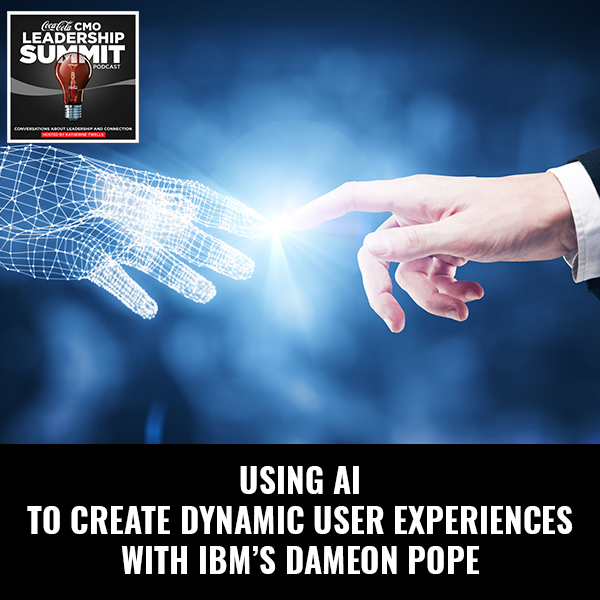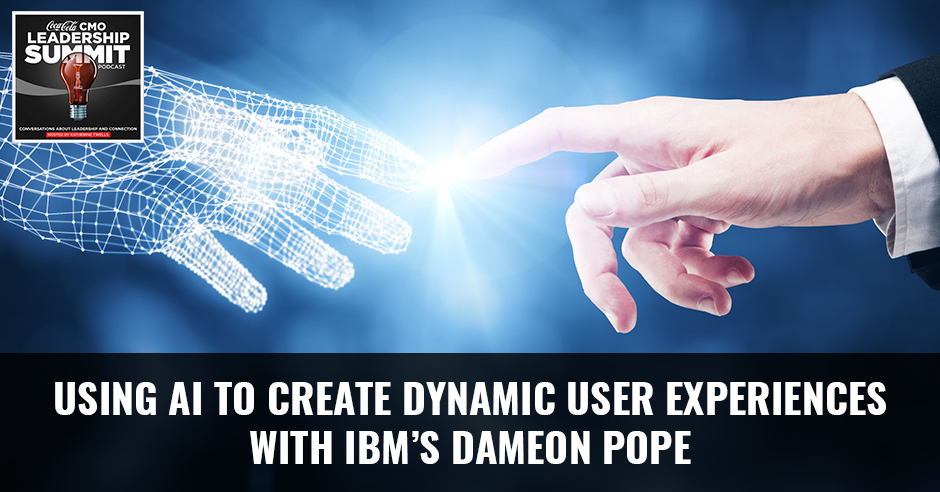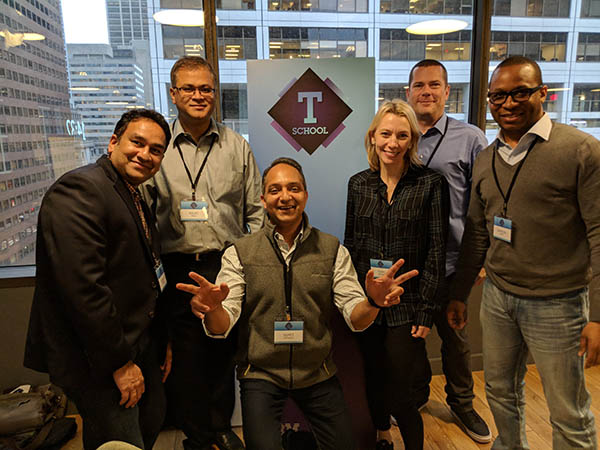Using AI To Create Dynamic User Experiences with IBM’s Dameon Pope


Technology has definitely changed the game for marketers to reach and connect people. It is not enough anymore to wait for them to come to you. Now, you have to put in the effort to actually get to them and have them respond. One of the great things that technology has helped businesses overcome that is using AI, which holds the power to create dynamic user experiences. Dameon Pope, partner at IBM iX, finds the ways it has turned data to inform marketers of a customer experience. Dameon goes deep into this topic as he speaks about design thinking, customer experience, data, and AI. He gives some great examples on how successful businesses were able to crack into that relationship between customers and technology.
—
Listen to the podcast here:
Using AI To Create Dynamic User Experiences with IBM’s Dameon Pope
This is Dameon Pope’s talk titled Using AI To Create Dynamic User Experiences from the 2018 Coca-Cola CMO Summit.
—
Design Thinking
Fundamentally, what’s happening in the marketplace is that we’re shifting to an experienced-based economy. Experiences are ruling the day. You can’t operate as an organization at this point without understanding that the customer experience is at the core of everything that you do. IBM figured this out a long time ago. It started to introduce this idea of design thinking into the organization. They partnered with the Stanford Design School to be able to bring in this idea of design thinking focused on business and how business does it. The reason why design thinking was important was that when you think about business, business is human. Design thinking helps to bring humans into the room to help to solve for business challenges. This is part of the reason why iX exists. We are considered the part of IBM that is focused on helping companies design their businesses and we do so by surrounding them around their customers. The reason we exist is primarily that the folks in this room told us that we should exist. 65% of CEOs and CMOs said the same thing. Their competitive edge, their future would be driven by the importance and the ability of their technology to be able to deliver an experience for customers. We put a lot of credence into this. We think that organizations are going to have to transform the way that they plan. The way they think about digital. The way they think about creating future shaping experiences. The way they think about creativity and the way that they put this technology to work.
All these things have to come together now. No longer can you say, “I’m going to spend a little bit of time planning and thinking through who my consumer is and what they want.” Developing a campaign idea and then launching it in the marketplace, all of that has to be integrated together. That planning process is fluid. You have to keep things moving. When you think about the experience revolution, this isn’t being driven by the technology that’s available. This is being driven by the expectations of the consumer. When you think about the responsive and personalized experiences that consumers expect, Ron brought up the tennis shoe that was following him around the Internet. Part of that is what consumers expect. Unfortunately, it’s not the adaptive fluid experience that they will expect in the future. In the future, you expect that at some point those ads are going to go away because you’re not interested in buying that shoe. If you’re shopping for bedding online, instead of showing a tennis shoe, it shows a slipper. These are things that consumers are expecting to do. You can’t go anywhere now without thinking about the impact that AI is having on every industry. Marketing is no different. There are some technologies now that allow you to be able to scan an eye and determine if someone has a high propensity for heart disease. Why can’t that same technology be used from a marketing perspective to help to understand whether or not someone’s interested in buying a shoe? We think about this daily. You probably also saw Google gave a demonstration of using AI to make phone calls.
You can't operate as an organization without understanding that the customer experience is at the core of everything you do. Share on XThese things are becoming pervasive in everything that we’re doing and we’re trying to find ways and marketers are trying to find ways to be able to bring that into the work that they’re doing every day. Our CEO, Ginni Rometty, has staked the entire company. She’s been big on AI driving every fundamental decision that we make, not just as marketers but as humans. If you guys are like me, every morning the first thing that I do is I check Waze. I check to see what my traffic and what my commute are going to be like. I look at the weather and all that is helping me as a human, enabling me to have a better day. From Ginni’s perspective, in the future, every decision is going to be informed by a cognitive system like Watson driving those decisions. We truly believe that, both for the marketer as well as for consumers. When you think about why this is important and why we’re in such an interesting space and time for this to all come to light.
Data And Customer Experience
Many years ago, when the big data revolution was underway. When everybody was talking about how important it was going to be to be able to store and capture and be able to populate data in various systems. Everybody invested in mega platforms. Everybody invested in the cloud. Everybody was throwing money at it. What that did was gave us a ripe, fertile playground to be able to play with data that didn’t exist many years ago. The truth is, only 20% or so of all data that are existing in the world now is searchable. What that tells you is that despite the fact that we have near infinite storage and we’ve got processes that can process this data, there are many sensors out there that are still required to be able to bring that data in so that we can use and leverage it. This is the time to jump in and say, “Before this gets way too overwhelming, you have to get in a place where you’re prepared to be able to address this day-to-day lose that’s underway.”
What does this mean for customer experience? There’s change that’s taking place with the way that people have to think about the way they use data to inform and drive the customer experience. IBM did a study of executives. There were 1,700 or so who saw two important things driving their future. One was this idea that AI would change the way they thought about approaching customer experience. What that means is, “How does data help me to inform the decisions that I make from a marketing perspective? How does the data that I get from my consumers help me to shape strategies and experiences that inform the customer experience?” On the other side, it also changes the way consumers think about your brand. Nancy Kramer, our Chief Evangelist, made a comment that your last best experience becomes your expectation for your next experience. If you had a great experience at an Uber, you’re expecting that when you go into a restaurant, you’re going to have a similar experience no matter what the connectivity may be or lack thereof. This is to give you a sense of how this comes to life, this reciprocal nature of expectation around data. Us giving data as consumers and us taking data as marketers to be able to use it. Amazon launched a four-star store. Conceptually, the idea behind the four-star store is that everything that Amazon sells that gets four stars or more shows up in this store, it’s like the Internet threw up in a store a little bit. If you ever get an opportunity to go in, you will be overwhelmed. I’ve got a few visuals as part of the experience.

User Experience: Your last best experience becomes your expectation for your next experience.
I was a little stalker walking around and taking pictures. It was day one that it opened. It was a field trip that we took some of our clients on to show them some of the things that Amazon was doing and that brands are doing to break the traditional retail process is using AI to do so. If you go into the store, what you’ll find is that you’ve got all of these product pairings that are out there where you’ve got a book on smoothies sitting next to a smoothie container. If you go in and you expect to find ten different blenders that you can choose from, you’re not. You’re only going to see the one that has the highest rating and has four stars. Conceptually, what this is doing is taking this idea that we all as humans aspire to, which is a sense of connectivity and belonging to something bigger than you to help you make decisions. When you think about the fact that they have ratings and reviews underneath each of the items that are inside of this store, it’s helping to inform your decision. From my perspective, the important part of that is that it is tapping into something innate and human and a behavior that we all exhibit. Whether the store exists or not in the next couple of years is not important. Dan talked about the concept of car versus production. I’m sure there are going to be components of this that makes its way into retail. I’m sure Target is studying this example. I’m sure they’re trying to figure out things that they can learn from it and be inspired by. What it does is demonstrates how AI can inform even real-life experiences.
AI And Marketing
One of the things that we did at iX was we looked at understanding humans, understanding human behavior and understanding how humans can be informed by AI. We can help marketers to understand how they should be applying AI, help to inform their brand and to support their brand. Doing AI for AI’s sake is the worst idea ever. We did a brand belonging study and the study was centered on this idea that people feel lonely. People are in this global state now where there’s a lot of isolation. People are on their phones, on their devices. They’re not connecting with other people. I feel yesterday was completely dedicated to this idea that we want to be and aspire to be more connected. We talked to 4,000 customers and had them evaluate 172 brands to help us understand what those drivers of belonging are? How do we help brands? How do we help the clients that we work with connect themselves to some of this human behavior, some of these human drivers that helped them to connect to their consumers? What we found was that these were some of the key things. These are no surprises to marketers, but these are some of the key things that called out. People want to feel joyful. They want to feel helped. They want to feel trusted. From our perspective as we think about and as you think about this layer of AI that you should be introducing into your marketing every day, they should be driving these kinds of values. They should not be things that we’re doing innovation for innovation’s sake. We’re trying to do some cool things to get people excited about the fact that we’re using AI. This is something that is important for us to latch ourselves onto because, at the end of the day, brands are about connecting with humans.
At the end of the day, brands are about connecting with humans. Share on XDesigning Experiences
I thought I’d share a few examples of some things that we’ve been doing primarily in the sports space. The Atlanta studio that I’m responsible for had its foundations built around the ‘96 Olympics. It’s to create and help inspire digital experiences for the Olympics. That culture of sport and connectivity still exists inside of this studio now. We do digital experiences for the Masters, for Wimbledon, for the US Open, for some of the more prestigious sports properties in the world. We do so with this idea that fandom is a sense of belonging. It’s amazing that some folks are still Dallas Cowboys fans. They haven’t won anything in 25 years, but there’s this sense of belonging that connects people to this brand. They are still considered the world’s most valuable sports property. Why is that? From our perspective, it’s this sense of belonging. To me, it’s short of religion. The only thing that I can think of in my mind that people are more connected to emotionally is religion. I’m a big fan of the Falcons, unfortunately. The Super Bowl loss was one of those things that I went into a deep depression for a couple of days, had to come back out. What it does is it taps into this idea that I have this sense of belonging. This sense of brotherhood with this team that I don’t know at the end of the day, but there’s something that connects them to me.
One of the things that Arthur Blank, who is the owner of the Falcons, we worked with him for a couple of years while they were building the new Mercedes-Benz stadium in Atlanta. It’s one of the newer stadiums out there in the market. He wanted to prioritize building that stadium from the ground up with the fan experience in mind. When I say from the ground up, the concrete they selected, the way that they wired it. Everything across the board was built with a fan in mind. IBM was one of the big partners who helped wire the stadium. They built it in a way that could ensure that when it was finally constructed and completed, there were ways for people to stay connected inside of the stadium. There were ways for people to be able to share content outside of the stadium. When you think about the stadium experience, they’re competing with a couch. They’re competing with that dual screen environment. How do you make sure that you could replicate that dual screen environment inside of a stadium? That was one of the things that we help to work on with this group.

User Experience: If a brand allows consumers to do things that they as humans couldn’t do, then level of value and connectivity to the brand increases.
I want to share what we’ve done, what we’ve been able to launch by taking advantage of the fact that we were involved in the infrastructure from the ground up and able to design experiences on top of that. On one hand, we were focused on developing and designing an experience that was fully integrated with all these various platforms. Whether it was the ticketing platform or the ability to be able to order food while you’re in your seat. We were thinking from our perspective that it was going to be a great experience for the fans. What we found was that they were able to leverage a lot of the data that came from the apps. It came from people connecting to the Wi-Fi networks around the stadium to determine things like traffic flow. Looking at where people congregate. Where should they have certain kiosks and certain stations? Where were people hanging out? It informed some of the next generations of changes that they’re making to the stadium, including creating a pedestrian bridge that crosses over the street to get to public transportation. It cuts down around sixteen minutes or so of folks being able to get out of their seat and to get home. We were able to create this reciprocal relationship between the stadium and the fan.
Another example is something that we did for Fox Sports. The setup for this though is something that we did a while back for the Masters. If we have any Masters’ fans in the audience, you will know that this is a multi-day event throughout the entire day. You can’t always be in front of your computer checking to see how Tiger’s doing. One of the things that we created was called AI Highlights. What we did was we ingested all of the live video content from the day. We extrapolated all the most exciting moments from that day either based on athletes that you were following or based on the day of the week that it was. We pull those together for a consumer to be able to look at it at the end of the day. It’s creating your own ultimate highlight. Fox Sports came to us and said, “Could you do that for the World Cup? Instead of focusing on the highlights for the World Cup and for those individual matches, could you go back many years? Determine the best highlights and the most memorable moments throughout the many years so that someone can customize and create their own a video?” The answer was yes. To me, if a brand brought this to a consumer and allowed them to do things that they as humans couldn’t do, it increases this level of value and connectivity to the brand. There are things in here that are baked in here that humans can’t do. When I think about AI, AI is not one of these things that we have to be afraid of that when you look at and it’s out here in front of us. From my perspective, AI lives over your shoulder. It informs you, it helps you, it empowers you and it pushes you along. This is a great example of who wouldn’t love to have customized content based on their favorite athlete, their favorite player all done for them in a matter of seconds. The question for you as brands is how do you take some of these experiences and think about applying them to some of the challenges that your consumers are having?
AI lives over your shoulder. It informs you, helps you, empowers you, and pushes you along. Share on XAnother example is something that we’re doing for fantasy football. Most people know what fantasy football is. Generally, you get to pretend to be a GM and you get to build a team based on that. One of the things that have happened around fantasy football over the last many years is that there’s been an entire industry built around fantasy football. Focused on the content people consume around fantasy football. Not just the blogs and the articles, but there are podcasts, there are TV shows and there are radio stations. Satellite radio stations dedicated to talking about whether or not somebody is going to have a good game or bad game or whether or not someone’s going to be injured or who the backup running back is going to be for this week. These are all things that are shoved out there in the universe. As a fantasy football player, you get inundated with all this content. There’s no way to consume it. What we did was created a way for Watson to be able to read and evaluate all of that content that’s out. It shows you in the app and as well as on dot-com what is the likelihood of an athlete to have a great week versus a bad week. What’s the general sentiment that’s happening out in the marketplace? We’re able to do that analysis and create an algorithm that helps us to figure that out. This is the problem that we’re solving.
The last example I’ll share and this is more of a cautionary tale than anything else. I’m sure most of you if you didn’t watch the US Open, particularly the Women’s Tournament, you heard about some of the events that happened. We do all the digital experiences for the US Open, including a Facebook Messenger bot that we created. Initially, the bot was answering questions. People were saying like, “I love Serena. When is she playing next?” We’re like, “She’s playing next on this court at 8:00. Here are some other athletes that you should take a look at. Did we answer your question?” “Yes, you did.” Long after the tournament is over, people were screaming and yelling like, “I love Serena. How could you do that to her? The umpire should be ashamed of himself.” What was happening is that Watson was seeing this sentiment and seeing the change that was happening in people’s sentiment and flagged us and said like, “There’s a lot of stuff going on in here that I can’t react to and I can’t respond to.” The statement, “I love Serena. You guys suck,” we can’t say, “It looks you’re interested in Serena. Here’s when she was playing this and here’s how she did. Did I answer your question okay?” We can’t do that. We had to step in. AI does not live here, does not replace anything. It lives over here. We had to step in and teach Watson how to react and respond to those things to give folks an outlet to be able to answer. I say that to say that you can’t launch AI and forget it and say, “We’ve got it. It’s done. It’s a tactic.” This is a way of life. This is something that you have to immerse into your organizations and make real.
Important Links:
About Dameon Pope
 Published, award-winning marketer with proven success deepening relationships between consumers and global, blue chip brands.
Published, award-winning marketer with proven success deepening relationships between consumers and global, blue chip brands.
Currently a Partner at IBM iX leading the Atlanta studio. Prior to IBM, lead a talented Engagement team at Huge. Ran a global loyalty marketing practice at Ogilvy for leading hospitality and CPG brands. Built a Customer Marketing agency within a leading global technology firm. Connected a luxury automotive brand with illusive consumer markets. Founding partner in a digital startup. Proven ability to position brands for growth through emerging digital channels. Advanced degree with a progressive, dynamic career spanning 17+ years.
Love the show? Subscribe, rate, review, and share!
Join The Coca-Cola CMO Leadership Summit Podcast community today:
AI, Customer, Design Thinking, marketing, Technology, User Experience